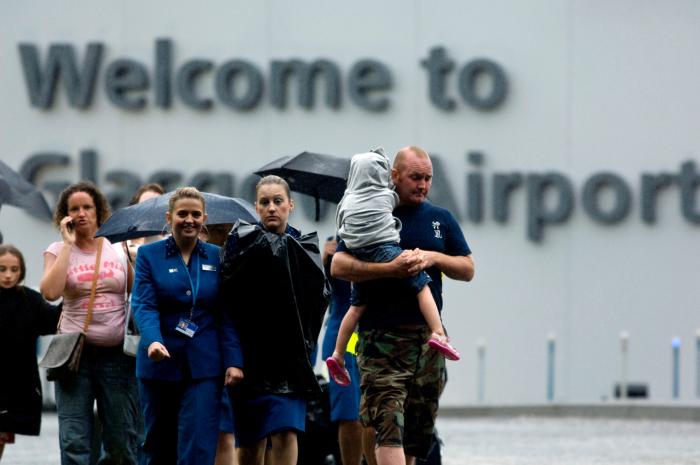Airport terminal evacuations are relatively uncommon, but preparing for them will always be crucially important.
Critical incident management consultant Richard Duncan gave Airports International his views, based on 30 years’ operational experience within the fire and rescue service in the UK.“Any evacuation during a critical incident becomes a much bigger challenge dependent on the particular circumstances,” he said.
“For example, if a chemical incident occurs within the terminal and the noxious substance enters the ventilation system, do the predetermined muster points for the evacuation remain valid? Who identifies alternatives? How is that communicated to the personnel directing the evacuation? Are the personnel directing the evacuation trained in dynamic risk assessment? Who makes the decisions and controls the evacuation process?
“This list could go on, but these are just a small number of the time-critical issues that need to be addressed in the initial stages of any evacuation prior to the appropriate emergency response being established, and a robust Common Recognised Information Picture [CRIP] being identified, followed by a suitable strategic, operational and tactical response being put in place.”
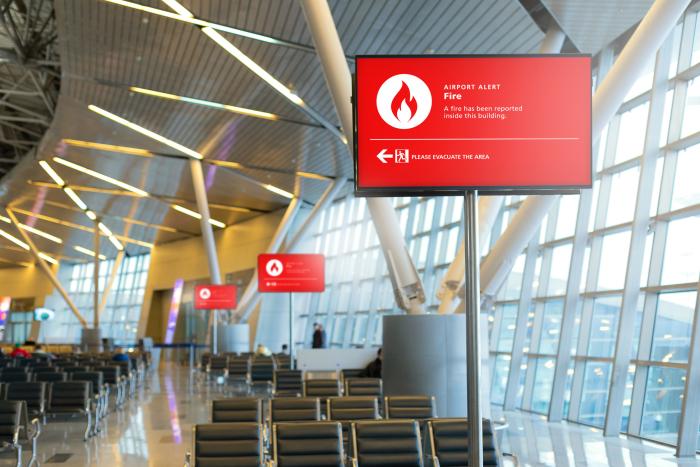
Key considerations
According to Duncan, airport evacuation processes should consider various factors, including: identifying the reason for the evacuation; whether the incident affects airside, landside or border-control management; the level of evacuation requirements; who will manage the evacuation at strategic, tactical and operational levels; how evacuation protocols are communicated.
Duncan said: “Does the integrated emergency response plan (if one exists) identify separate evacuation protocols for varying types of incidents? Who decides which evacuation plan should be followed? Does a separate casualty evacuation plan exist?”
He also noted that evacuations “are normally required in the incipient stages of an emergency prior to a detailed CRIP being available, and by their very nature are reactionary”. He added that operators need to ensure evacuation plans are flexible enough to be completely changed/upgraded/adapted and that there is a clear pathway, both from a communication and managerial perspective. According to Duncan, this is important as the responsibility for co-ordinating any required evacuation can pass from one agency to another dependent onthe circumstances.
Evacuation and muster areas need to be carefully managed to ensure choke points do not occur. Furthermore, Duncan said: “Routes that are not normally recognised as an ‘escape’ route have the capacity to allow the continuous and safe flow of large numbers of people in an emergency to escape to a place of safety, with a recognition that these routes also have to consider disabled and non-ambulant individuals.”
Human behaviour needs to be considered, too: people’s actions might also put themselves in harm’s way. “This can occur when individuals become familiar with a route. They normally travel in terms of predetermined evacuation routes, such as fire escapes,” Duncan explained.“
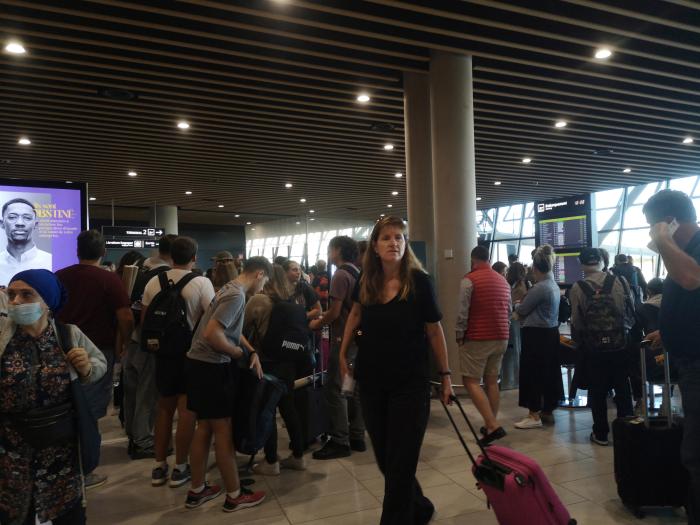
Identifying needs
It has been identified in the past that when an individual is located within premises they are unfamiliar with, in an emergency they will exit the building, using the route they entered, even when it is not the quickest.”
Duncan feels a ‘best practice’ CRIP does not exist specifically for airport evacuations, because any CRIP will follow a pathway that can be adapted for any given situation. The utility of a CRIP depends on answering several questions relating to relevance, accuracy, timeliness, the source of information, and its reliability.
Among the questions to be asked, he said, are: “How well does the information meet the needs of the end user? How well does the information reflect the underlying reality? How current is the information? Does previous experience of this source indicate the likely quality of the information? Is the information supported or contradicted by other information?”
The key in evacuations, according to Duncan, “...is how quickly this information can be gathered, by whom and how it will be communicated to those on the ground managing the evacuation. This again will be driven ultimately by the situation causing the required evacuation”.
Integrated responses
In the UK, airports are involved in the preparation, testing and exercising of Integrated Emergency Management (IEM) Response Options for any given situation under the Civil Contingencies Act 2004, as active members of Strategic Co-ordination Groups throughout the country.
Duncan explained: “The underlying aim of IEM is to develop flexible and adaptable arrangements that will enable effective joint response to any crisis whether foreseen or unforeseen. It is intended to build the resilience in the UK to deal with any emergency and, where necessary, to make specific arrangements to deal with particular risks.
“‘Restricted’ documents such as Multi Agency Incident Response Guides are prepared for specific locations, as a result of pre-planning testing and exercising, to ensure each organisation is aware of each responding agency’s actions during the incipient stages of an incident until a clearer understanding of the situation can be disseminated using the CRIP to inform the ongoing management of the incident.”
Duncan said that with all UK airports being recognised partners within the IEM Planning Groups, “I would suggest that adequate training and exercising is provided”. In his view, however, training for dynamic risk assessment and actions required during critical incidents could be improved for customer-facing staff.
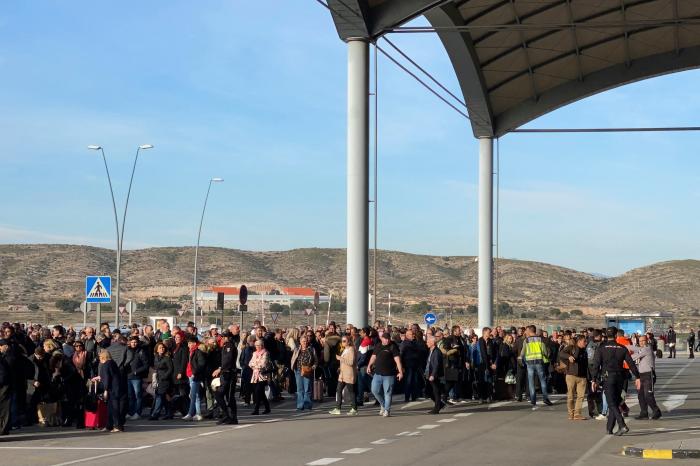
Signage matters
Clear communications to passengers are imperative during evacuations. A spokesperson from US firm Synect, which supplies the Passenger360 visual communications platform, told Airports International: “In any emergency situation, information presented to travellers must be clear, easily understandable, and visually distinctive.”
Synect’s Passenger360 platform includes an Emergency Messaging module. Emergency alert messages are prominently displayed in bright red with recognisable alert icons.
Emergency icons indicate the type of emergency through both text and visual symbols. Specific clear and actionable instructions can be presented to passengers, such as evacuating, taking shelter, or following airport officials’ directions. And green messages signal an ‘all clear’ state once the emergency has passed, helping calm and reassure passengers.
Synect’s system is customisable, giving airports an ability to activate, create and clear emergency messages specific to their facility and emergency/evacuation procedures. Ad-hoc messages can be created, with these messages also customisable for each airport.
The Synect spokesperson added: “Airports can specify their individual requirements for distributing emergency messages at various levels. A large airport may need the ability to distribute them airport-wide, to multiple terminals, a specific terminal, or an area or subgroup of an area within one terminal. A smaller airport may only need the ability to distribute the messages airport-wide, to one area, or even an individual screen.”
Synect’s content studio can develop emergency messages tailored to the airport’s location and potential hazards. There are permissions-based processes for who can create emergency messages, approve them, activate them, and more.
The company also has a product called ReadySeeGo, which it describes as a “turnkey visual communication solution” that includes content, software, and hardware to provide wayfinding and security screening information.
ReadySeeGo is provided in a secure, portable plug-and-play wheeled enclosure. Synect states that it is “deployable without dependency on construction” and is designed to work in hallways, corridors, areas of converging traffic, queues, and any other environment without impeding passenger flow. It has the same emergency messaging capabilities as Passenger360.
Synect CEO Yahav Ran said: “For any visual communication programme to be successful, especially one as critical as evacuation-related emergency messaging, airports need a system with effective content, flexible distribution, and the agility to react to real-time airport events.”
Best practices for signage in evacuations are “simplicity, accessibility, efficiency, and broad coverage”, Synect’s spokesperson said. “Emergency messaging should be easy to consume and understand, particularly during high-stress situations. Our use of colour psychology and icon-based imagery ensures that messages are clear and easily understandable to a diverse audience.”
The spokesperson added: “We prioritise user-friendliness by making it simple for airport operators to create and activate emergency messages… Emergency messaging should be playable across the entire airport or in various groups and subgroups of signs.
“Synect designed Passenger360 and the Emergency Messaging solution to maximise effectiveness by enabling airports to tailor the distribution of messages according to their needs, ensuring that the correct information reaches the right people at the right time.”
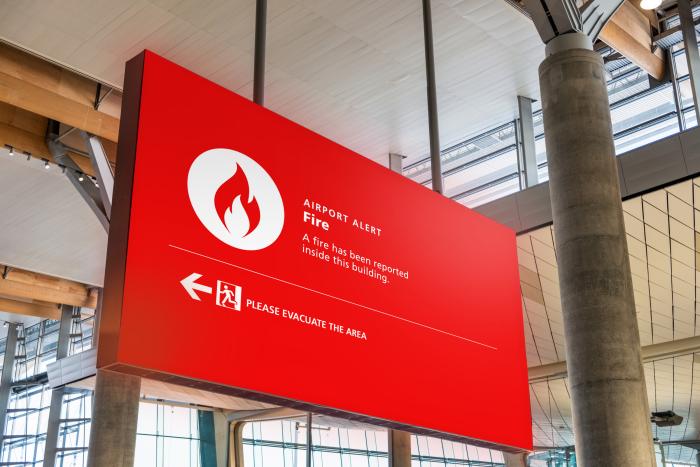
Bright and bold
Synect said: “The visual ecosystem prioritises content delivery, making safety messages bright, bold, and image-driven. This ensures passengers can easily understand them, including those who may not read English.
“The Emergency Messaging programme empowers airport operators to rapidly create and activate emergency messages. It includes a library of pre-created messages that can be deployed at any time and the ability to create custom messages on demand. The permissions-based workflow allows operators to create, manage, and activate messages seamlessly, aligning with each airport’s processes and procedures.“
Visual ecosystems can scale from kerbside to gates and back, and to multiple terminals, allowing airports to deliver messaging across the entire airport or in various configurable sets of signs. This scalability ensures that safety messages reach passengers throughout the airport effectively.”
According to Synect, the company’s products enable airports to “go beyond legacy digital signage with a platform and business decision engine custom-built for transportation”.
They said: “Passenger360 can consume and share airport data feeds, branding, wayfinding, airline ticketing displays, passenger screening information, wait times, multilingual content, and more.”
The ReadySeeGo solution also offers 24/7 operation, robust content playback, auto-recovery functionality, flexible data integrations, remote management capabilities, content synchronisation and automated scheduling. Greater Orlando Aviation Authority is a recent customer. CEO Kevin J Thibault said of the deployment: “This communication platform not only provides us with a dynamic way to display daily airport information, it also allows us to cater messaging to specific situations across our North and South Terminal complexes.”

Further reading: New technologies
Uri Guterman, vice-president of product at UK-based AeroCloud, told Airports International there is potential for leading-edge cloud and artificial intelligence technologies in airports’ emergency evacuation procedures.
In Guterman’s opinion, “too many rely on manual and on-premise processes and technologies”. He said: “For example, a lack of real-time information leaves designated airport operations teamsand rescue workers blind, should they need to understand where and howmany passengers are in a terminal and signpost optimal exit points. And on-premise hardware can also be easily damaged by fire or water, bringing down the IT infrastructure.”
Guterman said: “Cloud-based solutions are by far the better option. Hosted off-site, they ensure the continuation of technology infrastructure and services at airports, offering a greater level of resiliency to deal with unexpected events. These cloud-based applications democratise data for all airport stakeholders, including airport staff, airlines, ground handlers, FBOs and so on, empowering them to collaborate and make informed decisions based on real-time information. This data can also be accessed on mobile devices, so airport operations teams can remain connected and organised as they evacuate.”
He added: “Computer vision has also emerged as a key sector technology, enabling stakeholders to track and count passenger flow and dwell time. In the case of emergencies, team members can quickly identify whether an area of danger risks infringing on an evacuation and can plan accordingly.”

Further reading: Evacuation and PRMs
Airports Council International has a handbook, Airports and Persons with Disabilities, offering guidance for airport operators on accessibility for travellers with disabilities and passengers with reduced mobility (PRMs). It contains a chapter dedicated to the evacuation and use of aids for PRMs.
Airports are obliged to specify protocols for working with PRMs in the evacuation plan of a terminal building. Evacuation chairs must be available for stairs to the emergency doors to ensure the safety of PRMs duringan emergency situation.
London-headquartered Escape Mobility Company has more than 30 years of international experience developing and offering evacuation solutions. Today the company’s products can be found at over 30 European airports.
It says on its website: “People who would benefit from evacuation chairs are not just those in wheelchairs. Less able travellers or those suffering from short-term injury must also be catered for in an emergency.”
The company says its Escape-Chair has a “unique sliding/braking system” enabling braking “on all different kinds of stairs, from wood to concrete”, with the exceptions of spiral stairs and stairs steeper than 40°.
According to Escape Mobility Company: “This braking system is optimised by the weight of the evacuee, in combination with the pressure of the operator pushing down on the handle in the direction of the stairs.”
The chair, made from high-quality parts to provide extra comfort, can be equipped with a double ergonomic backrest, comfort seat, armrests and footrest. It is also available in a powered version.
